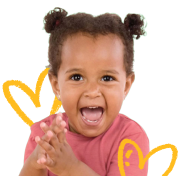We are excited to announce four new Baby Sign Language products. The products, a teaching guide, a dictionary, flash cards, and a wall chart will be available individually or bundled together as a kit.
 The Baby Sign Language Guide Book covers everything you need to know about teaching your child how to sign. Beginning with a Quick Start Guide, the book introduces your first ten signs and enables you to start teaching your baby in 30 minutes. As your baby progresses in signing, you can move to more advanced topics such as combining single signs into phrases and transitioning your child from signing to speech.
The Baby Sign Language Guide Book covers everything you need to know about teaching your child how to sign. Beginning with a Quick Start Guide, the book introduces your first ten signs and enables you to start teaching your baby in 30 minutes. As your baby progresses in signing, you can move to more advanced topics such as combining single signs into phrases and transitioning your child from signing to speech.
(128 pages, $19.95)
 The Baby Sign Language Dictionary contains more than 600 signs to expand your baby’s vocabulary beyond the basics. Each sign is illustrated with two diagrams showing both the starting and ending position as well as the intermediate motion. In addition to commonly used words, the dictionary includes the alphabet and the numbers 0-10.
The Baby Sign Language Dictionary contains more than 600 signs to expand your baby’s vocabulary beyond the basics. Each sign is illustrated with two diagrams showing both the starting and ending position as well as the intermediate motion. In addition to commonly used words, the dictionary includes the alphabet and the numbers 0-10.
(240 pages, $19.95)
 The Baby Sign Language Flash Cards include 52 of the most popular signs. In addition to the basics, the flash cards help you teach words such as train and zebra that your baby may not be exposed to on a daily basis. The front of each flash card displays the word and image to your baby. The back of each flash card shows how the sign is performed (a handy reminder for the teacher). Each flash card is made of sturdy paperboard and measures 4″ x 6″. ($24.95)
The Baby Sign Language Flash Cards include 52 of the most popular signs. In addition to the basics, the flash cards help you teach words such as train and zebra that your baby may not be exposed to on a daily basis. The front of each flash card displays the word and image to your baby. The back of each flash card shows how the sign is performed (a handy reminder for the teacher). Each flash card is made of sturdy paperboard and measures 4″ x 6″. ($24.95)
 The Baby Sign Language Wall Chart shows 17 basic signs including eat, drink, and sleep. The wall chart is a useful reference for caregivers such as grandparents, nannies, or babysitters, so they can interpret the basic signs your baby makes when you are away from home. The chart is also a helpful reminder in the early days when you are learning your first signs. The wall chart measures 24″ x 36″. ($9.95)
The Baby Sign Language Wall Chart shows 17 basic signs including eat, drink, and sleep. The wall chart is a useful reference for caregivers such as grandparents, nannies, or babysitters, so they can interpret the basic signs your baby makes when you are away from home. The chart is also a helpful reminder in the early days when you are learning your first signs. The wall chart measures 24″ x 36″. ($9.95)
The Deluxe Baby Sign Language Teaching Kit bundles all four products together for a special price of $39.95 (a $35 discount!).

We have worked hard on these products to get everything perfect and can’t wait for you to see them. More details on how to order coming soon.
If you want us to notify you when it becomes available, please subscribe to our blog using the form below or like us on facebook using the button on the right. Our fantastic Facebook community will always be in the know.










